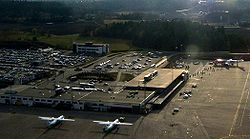Sandefjord Airport, Torp
|
Sandefjord Airport, Torp Sandefjord lufthavn, Torp |
|||||||||||
|---|---|---|---|---|---|---|---|---|---|---|---|
 |
|||||||||||
| Summary | |||||||||||
| Airport type | Public | ||||||||||
| Operator | Sandefjord Lufthavn AS | ||||||||||
| Serves | Sandefjord, Norway | ||||||||||
| Location | Sandefjord and Stokke, Vestfold | ||||||||||
| Focus city for | Widerøe | ||||||||||
| Elevation AMSL | 87 m / 285 ft | ||||||||||
| Coordinates | 59°11′12″N 010°15′31″E / 59.18667°N 10.25861°ECoordinates: 59°11′12″N 010°15′31″E / 59.18667°N 10.25861°E | ||||||||||
| Website | www.torp.no | ||||||||||
| Map | |||||||||||
| Runways | |||||||||||
|
|||||||||||
| Statistics (2015) | |||||||||||
|
|||||||||||
| Passengers | 1,542,541 |
|---|---|
| Aircraft movements | 42,139 |
| Cargo (tonnes) | 23 |
Sandefjord Airport, Torp (Norwegian: Sandefjord lufthavn, Torp; IATA: TRF, ICAO: ENTO) is an international airport located 4 nautical miles (7.4 km; 4.6 mi) northeast of Sandefjord, Norway and 110 kilometers (68 mi) south of Oslo. The airport features a 2,989-meter (9,806 ft) runway aligned 18/36. Torp partially serves as a regional airport for Vestfold and in part as a low-cost airport for Eastern Norway. Widerøe have a base at Torp, serving both domestic and international destinations. It also sees scheduled flights by Norwegian Air Shuttle, Ryanair, Wizzair and KLM Cityhopper. The airport served 1,851,181 passengers in 2013.
The airport was built largely with NATO funding as one of several bases to be used by the United States Air Force in case of war. Construction started in 1953 and the airport was opened on 2 July 1956. By then the military interest in the airport had dwindled. Civilian flights commenced in 1958 and in 1960 a municipal airport company was established to run a civilian sector. Vestfoldfly started operations the following year, and through a series of name changes and acquisitions has become the basis for Widerøe's operations at Torp. International services commenced in 1985 and Mediterranean charter services in 1992. The airport went through an expansion in the 1960s and in 1997 became a destination for Ryanair, who marketed it as an airport serving Oslo.
Following the end of the Second World War and Norway's subsequent membership in NATO, it became strategically important to build several new air stations in the country. This was based on a United States analysis from 1951, carried out by General Robert K. Taylor, which intended to station three wings, each of 75 aircraft, in Denmark and Norway. Each wing would have about 3,000 permanently stationed American personnel. Norwegian policy prohibited permanent stationing of foreign military personnel on Norwegian soil, but allowed the United States to build air stations that would be suitable for refueling before attacking targets within Eastern Europe. There were two main strategies that NATO intended to use that would require a new military air station in Southern Norway. The first was the "polar strategy", which involved NATO aircraft flying nuclear weapons into the Soviet Union. This would require refueling stations in Norway, but only about twenty permanently stationed personnel. The second was to station aircraft to allow a flanking maneuver if Soviet troops were to attack Central Europe.
...
Wikipedia

